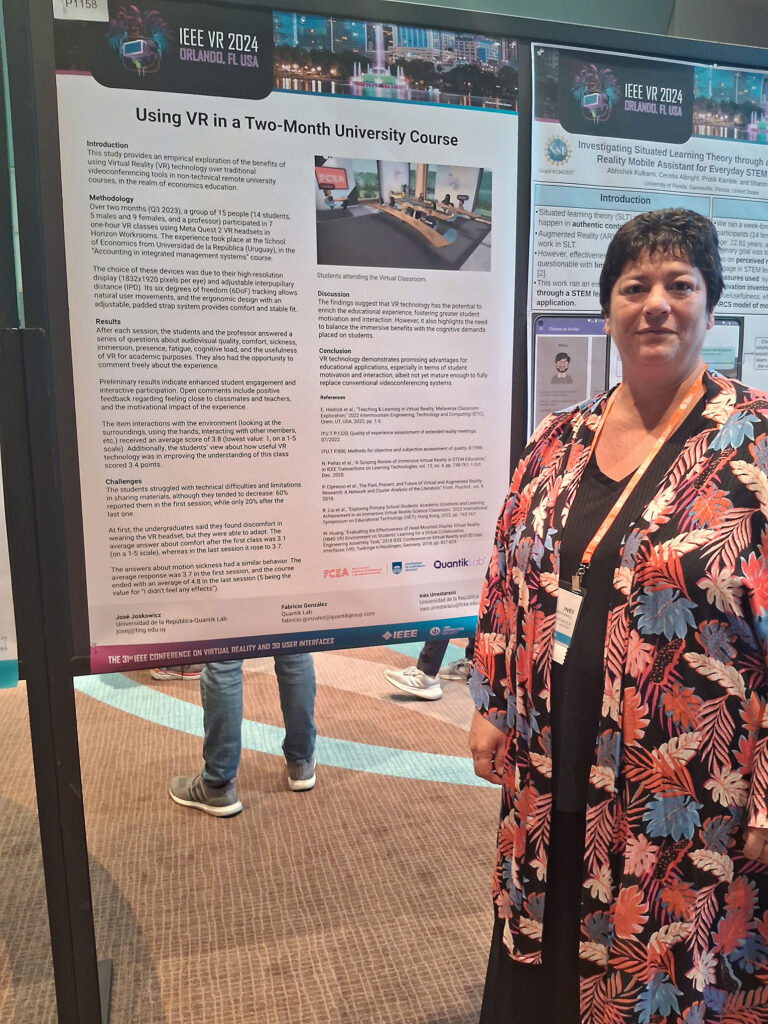Virtual reality is a promising option for bringing distance work closer to a more natural experience. In the field of executive education, they can open up opportunities to expand the classroom to the entire world, allowing the participation of professionals and students from all over the world.
In this context, IEEM, the Business School of the University of Montevideo, was interested in comparing two case discussion experiences: one carried out with virtual reality (VR) and the other in traditional format (in person). To meet this objective, together with Quantik Lab, Quantik's research and development area, they designed a joint experiment.
The initiative was carried out with the technical support and advice of Fabricio González and Martín Píriz from Quantik Lab. IEEM was represented by Pablo Sartor, Director of Operations and teacher, and Valeria Fratocchi, IEEM and Management Development Program teacher.
How was the experiment conducted?
For the development of the experiment, two brief cases were defined to discuss, A and B. Eighteen participants, 6 women and 12 men, were divided into two groups of 9 people (G1 and G2). Each group discussed two different cases, one in a virtual environment (V) using Oculus Quest 2 equipment, and one face-to-face (P). The following group-case-mode combinations were created: G1-A-V, G1-B-P, G2-A-P, G2-B-V.
The sessions consisted of discussions that were recorded. The metrics observed were the number of interventions and their duration, taking into account the differences by gender and modality of work.
What was observed during and after the experience?
In both modalities (face-to-face and VR) there was a similar distribution of time and interventions between teachers and participants. Teachers' interventions accounted for less than half of the total, and the average duration of interventions did not vary significantly between formats.

Regarding the gender of the participants, it was observed that women spoke on average more times than men, occupying a considerable percentage of the total time and interventions, despite being 33% of the total number of participants. These results remained consistent in both the face-to-face and VR discussions.
Regarding age composition, the study found that the G1 group presented a concordance between the average age and the age weighted by time of participation in both modalities, while in G2, despite a reduction in the weighted average age, the distribution was similar in the two modalities. Younger participants took more of the floor in both face-to-face and VR modalities.


Results vs. expectations
The initial expectations of those who guided the experiment suggested that the rhythm of alternation between the interlocutors would be greater in the face-to-face format, and that in VR the interventions would have a longer average duration, which would allow for greater expression; however, this was not the case. In fact, no noticeable differences were found in aspects related to the fluency of the discussion.
Similarly, the experience has led them to rethink certain preconceptions about the use of VR in facilitating interactions, especially when there are physical or logistical barriers to face-to-face presence.
Contrary to the popular belief that VR impedes fluidity in human interaction, this study demonstrates that it is not only able to effectively mimic the face-to-face environment, but also defies gender and age norm. Thus, in this environment women and young people had more opportunities to actively participate, revealing the potential of VR to democratize the classroom.
Professor Sartor considered that adding the "meta" modality to classroom work "can help to mitigate the difficulties of the public with complex schedules or who live far away, allowing to intercalate some remote instances with face-to-face attendance". He also valued the fact of learning to manage in these virtual contexts as a very valuable plus.



